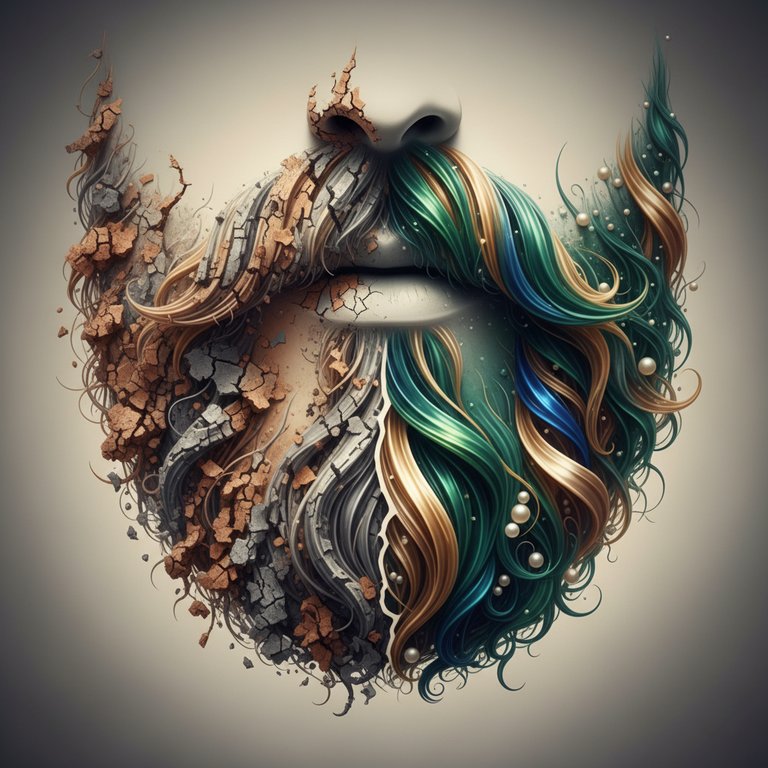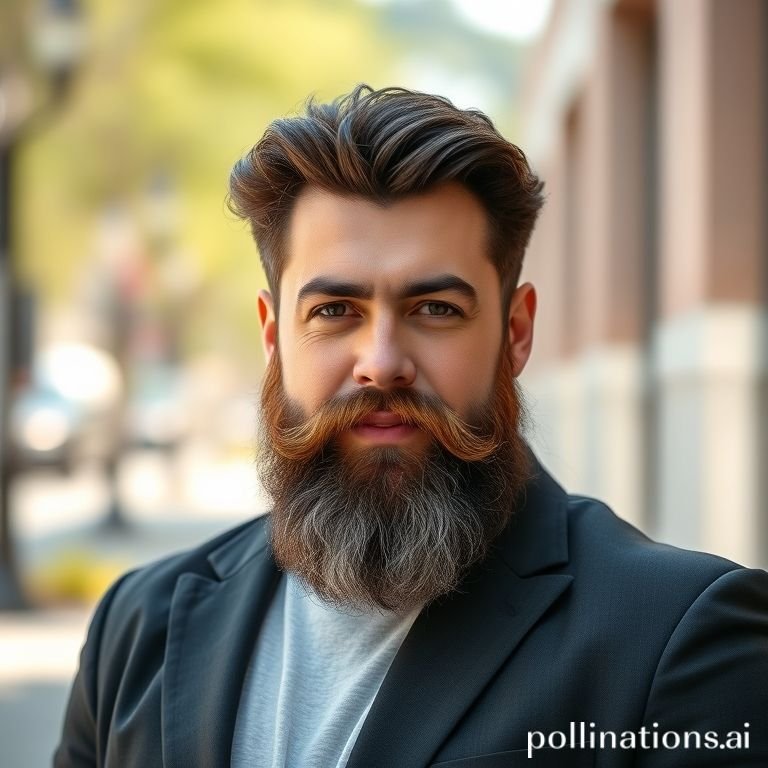Ever finished washing your beard, expecting that fresh, clean feeling, only to find it still feels... well, greasy? You're not alone, my friend! It's a common, and frankly, annoying beard problem that many of us have faced. You put in the effort, you use what you think are the right products, and yet, that unwelcome oily sheen persists.
Don't fret! A greasy beard doesn't mean you're doing anything fundamentally wrong, but it does mean there might be a few tweaks needed in your grooming routine. Think of me as your beard-savvy buddy, here to help you unravel the mystery of the greasy beard and get you back to feeling fresh and confident. We're going to dive deep into why this happens and, more importantly, how to fix it!
The Unexpected Culprits: Why Your Beard Feels Greasy
Before we can tackle the grease, we need to understand where it's coming from. It's often a combination of factors, and sometimes, the very things you're doing to 'help' your beard might actually be contributing to the problem.
Over-washing or Under-washing? The Tricky Balance
It sounds contradictory, right? But both extremes can lead to a greasy beard. If you're washing your beard too often, especially with harsh cleansers, you strip away its natural oils (sebum). Your skin then goes into overdrive, producing even more oil to compensate, leading to that greasy feeling. On the flip side, not washing enough allows natural oils, dead skin cells, and product residue to build up, resulting in a heavy, oily mess.
The Wrong Products for Your Beard Type
This is a big one! Many beginners make the mistake of using regular shampoo and conditioner designed for the hair on their head. Head hair and facial hair are different, and so is the skin beneath them. Regular shampoos can be too harsh, stripping away essential moisture and leading to the oil production cycle we just talked about. Dedicated beard washes are formulated to be gentler, cleansing without over-drying. Similarly, using heavy, non-absorbent beard oils or balms can sit on the surface and make your beard feel greasy.
Product Overload: Too Much of a Good Thing
We all love our beard oils, balms, and butters, but there's a fine line between nourishing your beard and drowning it in product. Applying too much beard oil, especially if your beard is short or naturally oily, will definitely leave it feeling slick and heavy. The same goes for balms and butters – a little goes a long way!
Environmental Factors and Lifestyle
Believe it or not, your environment and daily habits play a role. Humidity can make your beard feel heavier and more prone to oiliness. Sweat, dust, and pollutants from the air can also accumulate, contributing to that greasy texture. While we won't delve into specific health advice, it's generally understood that a balanced lifestyle can contribute to overall skin and hair health, which in turn can influence your beard's condition.
Are You Washing Your Beard Correctly? A Step-by-Step Refresh
Now that we've identified some potential culprits, let's talk solutions. Often, a simple adjustment to your washing routine can make a world of difference. Here’s a step-by-step guide to help you achieve a cleaner, less greasy beard:
Step 1: Choose the Right Cleanser
- Ditch the regular shampoo: Invest in a high-quality, dedicated beard wash. These are specifically formulated to cleanse your beard and the delicate skin beneath without stripping natural oils.
- Frequency: For most beard types, washing 2-3 times a week is a good starting point. If you're very active or prone to sweat, you might go every other day, but always listen to your beard!
Step 2: Lukewarm Water is Your Friend
- Temperature matters: Hot water can strip away natural oils, leading to dryness and compensatory oil production. Use lukewarm water to thoroughly wet your beard before applying cleanser.
Step 3: Lather Up, Gently
- Amount: Start with a small, dime-sized amount of beard wash. You can always add more if needed.
- Application: Work the wash into your beard, focusing on massaging it down to the skin beneath. This is where most of the oil and debris accumulate.
Step 4: Rinse, Rinse, Rinse!
- Thoroughness is key: This is crucial! Any leftover product will contribute to that greasy feeling. Rinse your beard thoroughly with lukewarm water until you feel no suds or slickness. Run your fingers through it to ensure all product is gone.
Step 5: Condition with Care
- Beard conditioner: After washing, apply a dedicated beard conditioner. This helps to hydrate and soften your beard.
- Application: Apply a small amount, focusing on the beard hair itself, not necessarily deep into the skin. Let it sit for a minute or two, then rinse thoroughly.
Step 6: Pat Dry, Don't Rub
- Gentle drying: Aggressively rubbing your beard with a harsh towel can cause frizz and damage. Gently pat your beard dry with a soft towel, ideally a microfiber one, leaving it slightly damp.
Step 7: The Post-Wash Ritual
- Beard oil/balm: While your beard is still slightly damp (not soaking wet!), apply a few drops of beard oil or a tiny dab of beard balm. The dampness helps the product spread evenly and lock in moisture.
- Less is more: Seriously, start with a very small amount. For oil, 2-3 drops for a medium beard is often enough. For balm, a pea-sized amount. Distribute it evenly from root to tip.
Beyond the Wash: Daily Habits for a Fresh Beard
Your washing routine is vital, but what you do between washes also makes a huge difference in keeping that greasy feeling at bay.
Brushing and Combing Regularly
A good quality beard brush (boar bristle is excellent) or a wide-tooth comb is your secret weapon. Regular brushing helps to distribute the natural oils (and any applied beard oil) evenly throughout your beard, preventing it from pooling at the roots and helping to remove loose hairs and debris. This also helps to exfoliate the skin underneath gently.
Mind Your Hands
We all do it – stroking, twisting, playing with our beards. But your hands carry natural oils, dirt, and bacteria. Constantly touching your beard can transfer these, making it feel greasy and potentially introducing unwanted elements. Try to be mindful of how often you're touching your beard throughout the day.
Cleaning Your Grooming Tools
Just like you wash your beard, you should clean your tools! Combs and brushes can accumulate old product, dead skin cells, and oils. A quick wash with some mild soap and warm water every week or two will keep them fresh and prevent you from reintroducing old gunk into your clean beard.
FAQ: Your Greasy Beard Questions Answered!
How often should I wash my beard if it feels greasy?
If your beard feels consistently greasy, it's tempting to wash it daily, but this can actually make the problem worse by stripping natural oils and encouraging overproduction. Try washing 2-3 times a week with a dedicated beard wash. On non-wash days, you can simply rinse it with lukewarm water and condition if needed.
Can using too much beard oil make my beard greasy?
Absolutely! Beard oil is fantastic for moisturizing, but like anything, moderation is key. If you're using too much, it won't absorb properly and will just sit on the surface, making your beard feel heavy and oily. Start with a few drops for a medium beard and adjust as needed. Your beard should feel soft and nourished, not slick.
What's the difference between beard wash and regular shampoo?
Regular shampoos are often formulated with harsher detergents designed to strip oils from the scalp and head hair. Beard washes, on the other hand, are much milder, pH-balanced, and designed to cleanse facial hair and the more delicate skin beneath without stripping essential moisture. Using regular shampoo can dry out your beard and skin, leading to compensatory oil production.
My beard feels dry AND greasy at the same time, what's going on?
This is a classic sign of your skin overcompensating! Your skin might be dry underneath (perhaps from harsh washing or lack of conditioning), prompting your sebaceous glands to produce excess oil. The oil sits on the surface, making it feel greasy, while the underlying hair and skin remain dry. Focus on using a gentle beard wash, a good conditioner, and a small amount of beard oil to rebalance.
How long does it take for my beard to adjust to a new washing routine?
Patience, young padawan! Your beard and skin need time to adjust. You might notice an improvement within a week or two, but it could take 3-4 weeks for your skin's oil production to fully rebalance. Stick with your new routine consistently, and you'll likely see positive results.
Should I use beard balm or beard butter if my beard is already greasy?
If your beard is already feeling greasy, you might want to temporarily reduce or pause your use of heavy balms and butters, as they contain waxes and butters that can add to the oily feeling if overused. Focus on a very light application of beard oil (just a few drops) to moisturize, and ensure your washing and rinsing routine is spot on. Once your beard feels more balanced, you can reintroduce a small amount of balm for styling.
Is it okay to just rinse my beard with water sometimes instead of washing?
Absolutely! On non-wash days, a thorough rinse with lukewarm water can be very beneficial. It helps to remove superficial dirt and refresh your beard without stripping its natural oils. Follow up with a light application of beard oil to lock in moisture.
Conclusion: Embrace the Freshness!
Dealing with a greasy beard can be frustrating, but with a few simple adjustments to your routine and a little patience, you can absolutely achieve that clean, healthy, and soft beard you're aiming for. Remember, it's all about finding the right balance for your unique beard and skin. Experiment with frequencies, product amounts, and techniques until you hit that sweet spot.
Keep those whiskers looking sharp, my friend, and enjoy the journey!
Disclaimer: This content is for informational and grooming purposes only and is not intended to provide professional or medical advice. Always consider your individual needs when establishing a grooming routine.


